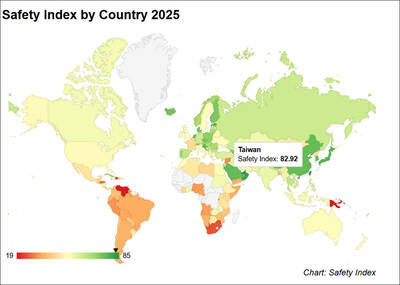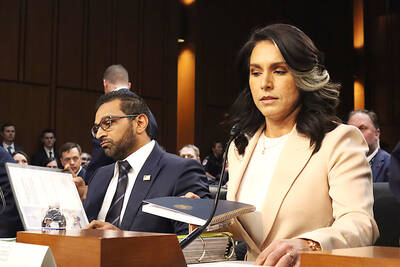The Ministry of Foreign Affairs (MOFA) yesterday confirmed the existence of a memorandum of understanding (MOU) signed between China and the WHO in 2005, contradicting comments by President Ma Ying-jeou (馬英九) a day earlier.
The existence and content of the MOU have been discussed publicly on numerous occasions by MOFA and its Chinese counterpart, but on Monday, President Ma Ying-jeou (馬英九) raised eyebrows by saying he could not be certain that the document existed because the Chinese Nationalist Party (KMT) “was not in power in 2005.” He challenged the former Democratic Progressive Party (DPP) administration’s claim that the document was signed to limit Taiwan’s participation in the organization.
“We are uncertain whether China signed an MOU with the WHO, but we don’t wish to see any such documents. However, we have heard about the signing of this secret MOU. But because [the KMT] was not in power at the time, we have no way of finding out,” Ma said in an interview with Taiwan’s China Television.
But MOFA Spokesman Henry Chen (陳銘政) told the Taipei Times last night that the ministry’s position on the matter was clear.
“They signed the MOU, but we have never recognized it or acknowledged its power to restrict our interaction with the WHO,” he said. “As an independent sovereignty, we have been protesting this since 2005.”
Ma’s comment ignored past press briefings, annual reports and interviews in which both MOFA and the Department of Health (DOH) have recognized that the MOU exists. A Central News Agency (CNA) report last month quoted Department of Health Minister Yeh Ching-chuan (葉金川) as saying the 2005 MOU had restricted the participation of Taiwanese health experts in WHO-related activities.
The Formosan Association for Public Affairs has also published on its Web site a facsimile of what appears to be a WHO document titled “Implementation of the Memorandum of Understanding Between the WHO Secretariat and China.”
Asked whether the Ma administration was persisting in its protest to the WHO over the document, Chen reiterated that the government did not recognize its validity.
Regardless of whether an MOU was signed, it has no power to restrict anyone, he said.
“MOFA has never cared whether China and the WHO signed an MOU or not. By definition, an MOU is between the two signatories, so why should [Taiwan] concern itself about it?” he told the Taipei Times.
“If we are not restricted in any way, we should just ignore it because it literally does not exist or have any efficacy. Why do you want to bring it up?” he said when contacted again for further comment.
Chen said the WHO’s inclusion of Taiwan in the International Health Regulations (IHR) in January and its invitation of the country to the World Health Assembly (WHA) as an observer showed that Taiwan’s participation had not been constrained.
Chen said an MOU between two parties does not constrain a third party, but if it does, the third party will refuse to recognize it. Taiwan has never recognized the MOU, he said, adding that he had never seen it.
Chen also said yesterday that Taiwan’s accession to the WHA as an observer was the fruit of direct consultations with the WHO.
On April 30, a CNA report quoted WHO spokesman Thomas Abraham as saying “the WHO was not involved at all” in Taiwan’s accession to WHA this year.
At the time, the Taipei Times contacted Chen for comment, who said the ministry would not comment without verifying the report.
Yesterday Chen declined to comment on the matter again, saying the ministry was still verifying Abraham’s remarks.

AIR SUPPORT: The Ministry of National Defense thanked the US for the delivery, adding that it was an indicator of the White House’s commitment to the Taiwan Relations Act Deputy Minister of National Defense Po Horng-huei (柏鴻輝) and Representative to the US Alexander Yui on Friday attended a delivery ceremony for the first of Taiwan’s long-awaited 66 F-16C/D Block 70 jets at a Lockheed Martin Corp factory in Greenville, South Carolina. “We are so proud to be the global home of the F-16 and to support Taiwan’s air defense capabilities,” US Representative William Timmons wrote on X, alongside a photograph of Taiwanese and US officials at the event. The F-16C/D Block 70 jets Taiwan ordered have the same capabilities as aircraft that had been upgraded to F-16Vs. The batch of Lockheed Martin

GRIDLOCK: The National Fire Agency’s Special Search and Rescue team is on standby to travel to the countries to help out with the rescue effort A powerful earthquake rocked Myanmar and neighboring Thailand yesterday, killing at least three people in Bangkok and burying dozens when a high-rise building under construction collapsed. Footage shared on social media from Myanmar’s second-largest city showed widespread destruction, raising fears that many were trapped under the rubble or killed. The magnitude 7.7 earthquake, with an epicenter near Mandalay in Myanmar, struck at midday and was followed by a strong magnitude 6.4 aftershock. The extent of death, injury and destruction — especially in Myanmar, which is embroiled in a civil war and where information is tightly controlled at the best of times —

Taiwan was ranked the fourth-safest country in the world with a score of 82.9, trailing only Andorra, the United Arab Emirates and Qatar in Numbeo’s Safety Index by Country report. Taiwan’s score improved by 0.1 points compared with last year’s mid-year report, which had Taiwan fourth with a score of 82.8. However, both scores were lower than in last year’s first review, when Taiwan scored 83.3, and are a long way from when Taiwan was named the second-safest country in the world in 2021, scoring 84.8. Taiwan ranked higher than Singapore in ninth with a score of 77.4 and Japan in 10th with

SECURITY RISK: If there is a conflict between China and Taiwan, ‘there would likely be significant consequences to global economic and security interests,’ it said China remains the top military and cyber threat to the US and continues to make progress on capabilities to seize Taiwan, a report by US intelligence agencies said on Tuesday. The report provides an overview of the “collective insights” of top US intelligence agencies about the security threats to the US posed by foreign nations and criminal organizations. In its Annual Threat Assessment, the agencies divided threats facing the US into two broad categories, “nonstate transnational criminals and terrorists” and “major state actors,” with China, Russia, Iran and North Korea named. Of those countries, “China presents the most comprehensive and robust military threat